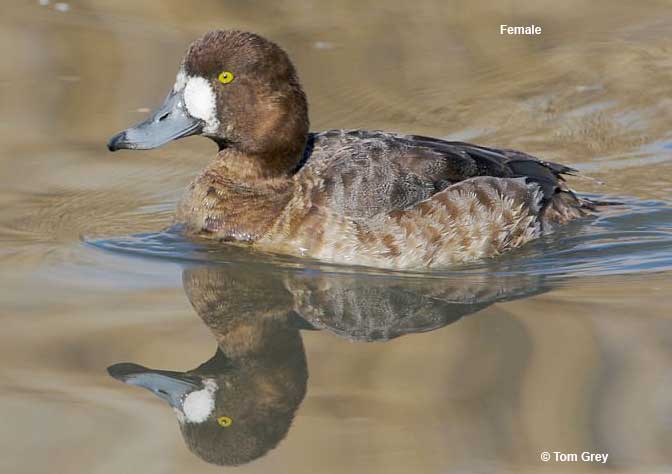Greater Scaup (Aythya marila) is a medium-sized diving duck with a big, blue-gray beak. Breeding males are pale gray above and white below with a black chest, head, and rear end. Females and non-breeding males are dark brown with white on their belly and the base of their bill.
Flocks of black and white ducks with dark green heads, black chests, and blue bills wintering in coastal bays could be this species. Watch for dark brown females with white on their faces. If the ducks take flight and show a long white stripe in their wings, you are probably seeing Greater Scaup.
Have you ever wondered why this species is known as the Greater Scaup? Learn the answer to this and other questions about this handsome duck in this article!
On this page
Identification
Greater Scaup is a medium-sized duck with a short, dark, squared tail, yellow eyes, and a small black tip on its big, blue-gray beak. On average, they are 18 inches long, have a 28 inch wingspan, and weigh 2.3 pounds.
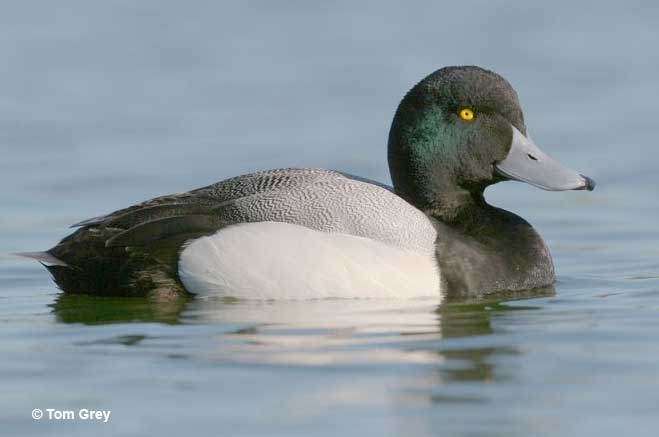
Male Greater Scaup in breeding plumage have fine gray barring on their back, a blackish head with glossy green highlights, and a black chest. They also have snow white on their sides and belly, and a black rump, tail, and undertail.
From July to September, males have a blackish head and chest but the rest of their plumage is dingy brown and gray. Females and young birds resemble non-breeding males but have a large white patch on the base of their dark gray beak.
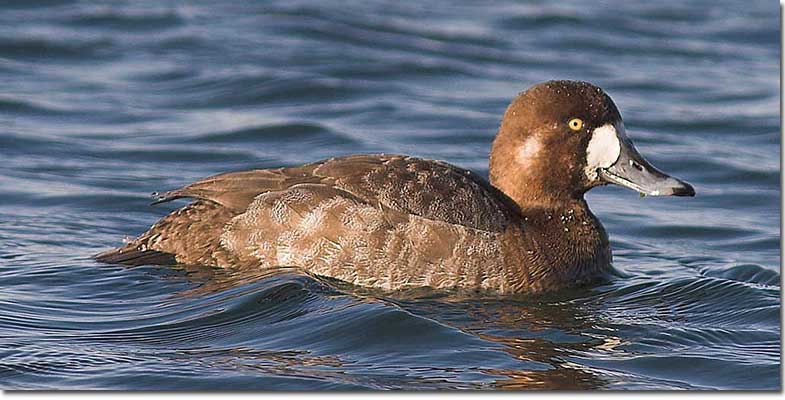
Female Greater Scaup
Female Great Scaups also have more brown on their flanks and are overall, darker brown birds than adult males.
In their fast and direct flight, all Greater Scaup show white bellies, and white on the underside of their wings. These ducks also show a broad white “stripe” on most of the flight feathers of their wings (around three-quarters of the wing length).
Vocalizations
Greater Scaup tend to be quiet birds. However, they can make some repeated, odd, nasal calls, that sound like vrewt vrewt vrewt vrewt.
Food
Greater Scaup eat lots of small mollusks, fish eggs, insects, and other small aquatic creatures. Their diet also includes a good deal of aquatic plant matter, and they occasionally feed on dead fish they find under the water.
This species loves to feed on Zebra Mussels and small clams. In some places, they can also feed on lots of mussels as well as snails and crustaceans. In general, the main part of their diet varies and depends on what’s happens to be most available.
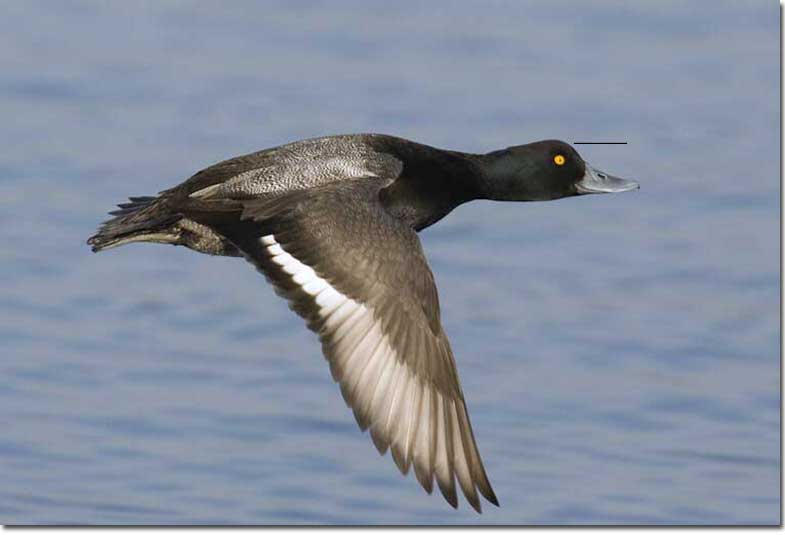
Greater Scaup can dabble on the surface of water for insects and other small bits of food. However, they mostly feed by diving below the water and picking food from the bottom. They much prefer to feed in shallow bodies of water with soft, silty, or muddy substrates.
In such wetlands, their favored feeding spots are places where high levels of nutrients support good populations of mollusks. For this reason, they can also concentrate their feeding at water intakes covered in Zebra Mussels.
To catch these important food items, Greater Scaup dive down, usually for around 20 seconds, and use their beak to probe the bottom. They can filter out and eat small creatures right then and there but bring larger food items to the surface.
Nesting and Eggs
Greater Scaups form pairs on wintering grounds and during spring migration. After reaching their breeding grounds, females pick a nest site and lay their eggs two weeks later. They always choose a spot with dense vegetation and fairly close to ponds, lakes, and slow-moving rivers in tundra or large wetlands.
Although they don’t really build much of a nest, female Greater Scaup make a shallow depression on the ground, underneath sedge and dense grass. They use grass and other vegetation to give their nest a bit of structure, and eventually line it with down feathers.
The mother duck lays 5 to 13 (but usually 8 or 9) brownish, olive-buff eggs that are 2.6 inches long. After she incubates them for 23 to 28 days, the baby ducklings hatch and are covered in soft down. Within 24 hours, their mother leads them away from the nest and to good, sheltered feeding sites.
The young birds feed themselves, mostly taking insects and other small creatures from the surface of the water. However, two weeks after hatching, the ducklings also start diving for food.
They stay with their mother until they become larger, much more independent, and capable of flight. At that point in time, the young birds flock with each other until eventually joining flocks of adult birds.
Current Situation
The Greater Scaup is a fairly common species that breeds in shallow wetlands in tundra and large, open wetlands. Flocks winter in bays, shallow coastal waters, and in large lakes. This species nests in Alaska, northern Canada, Iceland, and northern Eurasia, and winters from Canada to northern Mexico, Europe, and central and eastern Asia.
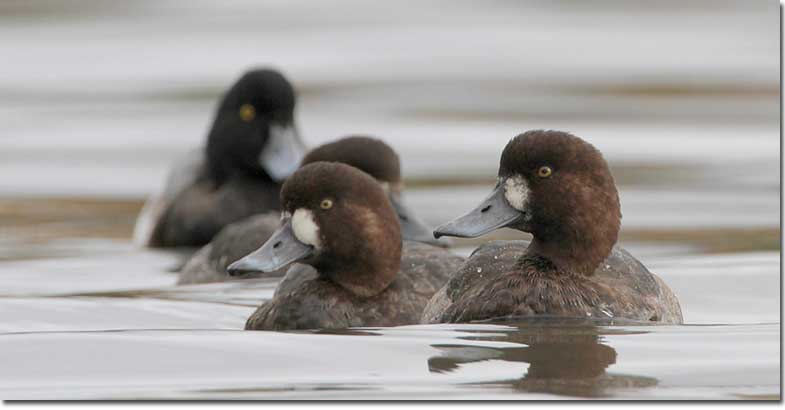
Greater Scaup female
The Greater Scaup is listed as Least Concern in the IUCN Red List and is a fairly common bird.
This duck species has a big range and is also believed to have a large population that is not gravely threatened. However, since it is very difficult to make an accurate assessment of its population, there could be fewer Greater Scaup than we think.
It has definitely declined in some wintering areas and is susceptible to oil spills and other types of pollution. To keep this species from becoming threatened, conservation measures need to reduce pollution, and have a better understanding of its population size.
Facts
- A good percentage of the Greater Scaup that breed in North America winter on the Atlantic Coast. One of the most important wintering areas in Long Island Sound. This site is ideal for the Greater Scaup because it has shallow waters and good mollusk populations.
- When female Greater Scaup incubate their eggs, their mates move to large lakes with good amounts of food and cover. They do this so they can change (molt) their feathers in safety. When Greater Scaup molt, they become temporarily flightless.
- On account of the color of their beak, Greater Scaup are often known as “Bluebills”.
- Greater Scaup feed during the day, but sometimes, they also feed at night. This may be related to certain food items being more abundant or easier to catch at night. Such feeding behavior could also be associated with tides that reveal more mollusks and other food.
- Like many ducks, this species sleeps while floating on lakes, reservoirs, or other large bodies of water. They typically sleep with their head resting on their back.
Similar Species
The Greater Scaup is a distinctive duck species. However, it can be easily confused with a few other, related species.
Lesser Scaup
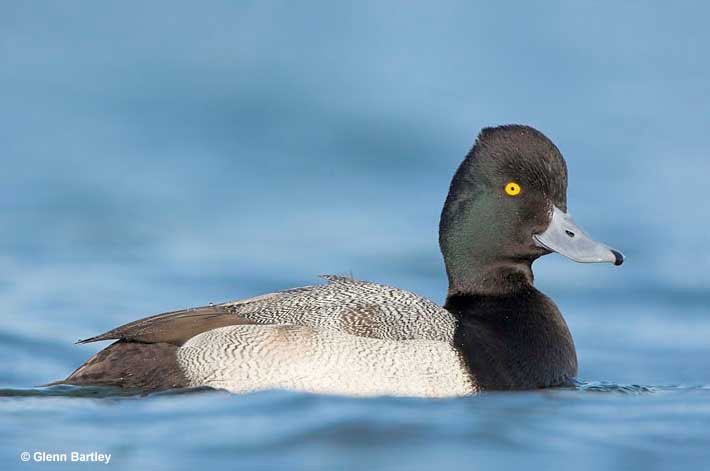
Lesser Scaup is very similar to the Greater Scaup. Separating them requires a good look where you can focus on a few key features. One of those features is the shape of their heads. Lesser Scaups have a slight peak on the back part of their crown, while Greater Scaups have more of a bulging forehead.
The Greater Scaup’s beak is also larger and has a bigger black tip. In flight, we need to focus on their wings. If the scaup has white for three fourths of the wing’s length, it’s a Greater Scaup. If the amount of white is on half the length of the wing or less, the bird is a Lesser Scaup.
Ring-necked Duck
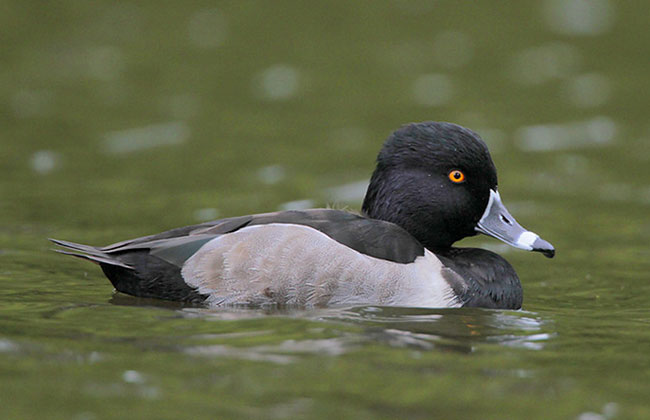
Photograph © Greg Lavaty
Ring-necked Duck is another black and white duck that can be occasionally found with the Greater Scaup. However, males have a black back, grayer sides, and a black and white beak. Females have a paler, grayer face, lack the large white face patch, and have narrow pale spectacles.
Tufted Duck
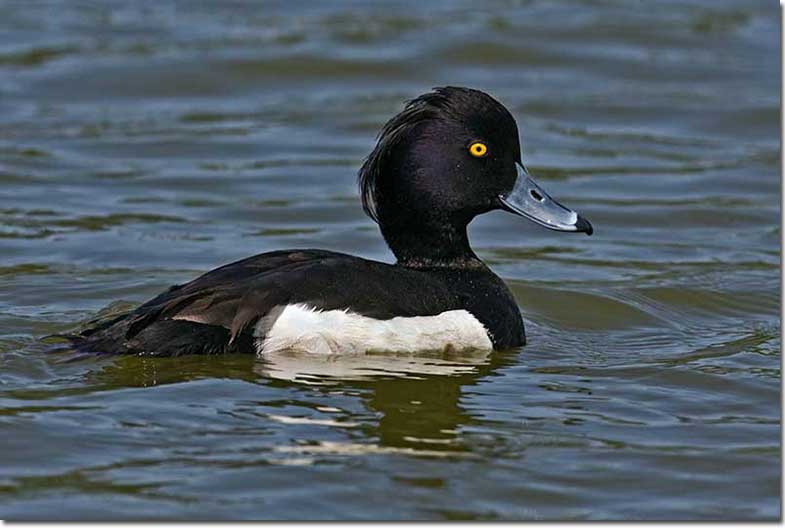
Tufted Duck, a rare vagrant from Eurasia can also be seen with Greater Scaup. Males have white sides like the Greater Scaup but have a black back, and a loose tufted crest. Females are colored a lot like female Greater Scaup but have much less white on their face and have a short, tufted crest.
Frequently Asked Questions
Where are Greater Scaup found?
Greater Scaup are found in large, northern wetlands, and on large lakes, reservoirs, and bays from Canada to northern Mexico.
What is the difference between a Lesser and Greater Scaup?
The difference between a Lesser and a Greater Scaup is the shape of the head, size of the beak, and wing pattern. Lesser Scaups have more peaked heads, smaller beaks, and less white in their wings.
What is the diet of a Greater Scaup?
The diet of a Greater Scaup includes small mollusks, crustaceans, insects, and aquatic plants.

